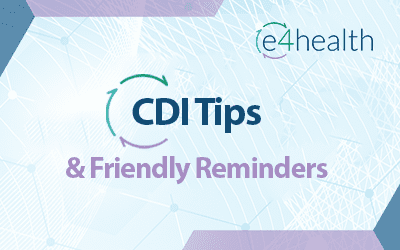Coding and CDI Tips
Sharing knowledge, experience, innovations and best practices to help organizations keep pace in the ever-changing healthcare industry
Coding and CDI Tips
Coding Tips: Local Invasion of Cancer
Local Invasion of Cancer (2Q 2025 Coding Clinic)Pathology findings indicate poorly differentiated carcinoma/right renal cell carcinoma, invading the renal vein and renal sinus after a right robotic radical nephrectomy on an inpatient stay. Assign only code C64.1,...
CDI Tips: Intellectual Disability
Topic: Intellectual Disability Definition: Intellectual disability, formerly known as mental retardation, characterized by: Impairment of intellectual function (IQ< 70) Associated with adaptive behavior problems Begins prior to age 18 Disrupts abilities necessary...
Coding Tips: EDAC
Excessive Dynamic Airway Collapse (EDAC) (2Q 2025 Coding Clinic)Excessive Dynamic Airway Collapse (EDAC) refers to a condition where the posterior tracheal membrane excessively bows forward into the airway lumen during expiration, causing dynamic narrowing....
Coding Tips: Accelerated Idioventricular Rhythm
Accelerated Idioventricular Rhythm (AIVR) (2Q 2025 Coding Clinic)AIVR is a hemodynamically stable rhythm and can occur after a myocardial infarction during the reperfusion phase or after cardiac ablation. Idioventricular rhythm is similar to ventricular tachycardia,...
Coding Tips: Viral Myocarditis due to COVID-19 (1Q 2025 Coding Clinic)
Viral Myocarditis due to COVID-19 (1Q 2025 Coding Clinic) There was a revision made to the ICD-10-CM Alphabetic Index, effective April 1, 2025 per the Centers for Disease Control and Prevention’s (CDC) National Center for Health Statistics (NCHS) during a recent...
Coding Tips: Zero Balance Ultrafiltration/Z-BUF (1Q 2025 Coding Clinic)
Zero Balance Ultrafiltration/Z-BUF (1Q 2025 Coding Clinic)Ultrafiltration is used to maintain volume management and/or filter the blood in order to reduce the adverse effects of hemodilution during cardiopulmonary bypass (CPB). Hyperkalemia is common while on CPB and...

